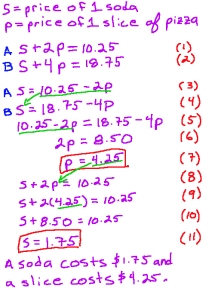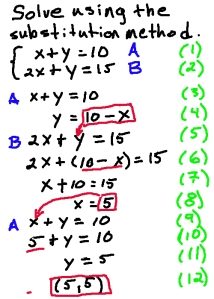I have not blogged about equivalent equations, but to solve a system of equations sometimes requires you to change one or both of the given equations. Below is an example of two equivalent equations.
5x + 25y = -55
You can multiply the equation above by any number you wish. Keep in mind you can multiply by fractions to create an equivalent equation. Multiplying 5x + 25y = -55 by 1/5 gives
x + 5y = -11 .
When you encounter a system of equation that does not have the same or opposite coefficients, you will need to create one or two equivalent equations, thus the name of the lesson is Solving Systems of Equations with Equivalent Systems. Once you create your equivalent system, you proceed with the same steps outlined in my post on Solving Systems of Equations Using the Elimination Method.
3x + 7y = 15
Example 1 Solving a System of Equations with an Equivalent System
4x + 6y = 36 (1)
-3x + 5y = 49 (2)
You should notice that neither of the variable terms have the same coefficient with the same or opposite signs. You should create 2 equivalent equations. There are several choices for this problem, but for this example the x-terms will be eliminated. To eliminate the x-terms, equation 1 should be multiplied by 3 and equation 2 should be multiplied by 4. The will give the equivalent system
12x + 18y = 108 (4),
-12x + 20y = 196 (5).
Now that the x-terms have the same coefficient with different signs, the equations will be added term by term to give:
38y = 304 (6).
The y-coordinate of this solution is found by dividing both sides of equation 6 by 38 to show
y = 8 (7).
At this point, any equation 1 through 4 could be used to find the value of the x-coordinate. Personally, I will choose one of the original equations. Substituting 8 in for the y in equation 1,
4x + 6(8) = 36 (8) Substitution Property (=)
4x + 48 = 36 (9) Simplify
4x = -12 (10) Subtraction Property (=)
x = -3 (11) Division Property (=)
So, this system has one solution of (-3,8). Even if you are confident in your math, you should check your solution by substituting the ordered pair and simplifying. Using equation 2,
-3(-3) + 5(8) = 49 (12) Substitution Property (=)
9 + 40 = 49 (13) Simplify
49 = 49 (14) Simplify.
Since 49 indeed equals 49, this system is consistent and independent, thus it has one solution (-3,8).
Example 2 Solving a System of Equations with an Equivalent System
In the image to the right the original system is on lines 1 and 2. The original system is change into an equivalent system by multiplying equation 1 by 5 and equation 2 by 3. The result is equations 3 and 4 on lines 3 and 4 respectively.
Because the y-terms have the same coefficient with opposite signs the equations will be add term by term to eliminate them. This give line 5 with only the x-term remaining. Dividing both sides of line 5 by 56, gives the x-coordinate as -1.
On line 8 and using equation 1, substitute the -1 in for the variable x and solve the equation by adding 6 to both sides and dividing both sides by 3 to give y = -3 (lines 8 – 13). The end result is the ordered pair of (-1,-3).
As always, checking the solution is an essential ingredient to solving any algebra problem. As the image show, the ordered pair does satisfy equation 2. Therefore, this system is consistent and independent.
Filed under: Algebra 2, Equations and Graphs, Solving Systems of Equations | Tagged: 2 variable system of equations, Algebra 2, solve a system of equations with 2 variables, solve a system of equations with the multiplication and elimination methods, Solving a system of equations, solving a system with 2 equations, Solving Systems of Equations with Equivalent Systems, Solving Systems of Equations with Multiplication | 1 Comment »





